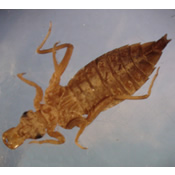|
|||||||||||||||||||
| Distinguishing Characteristics | |||||||||||||||||||
|
|||||||||||||||||||
| Additional Pictures | |||||||||||||||||||
|
|||||||||||||||||||
| Ecology | |||||||||||||||||||
| Habitat
With 14 Genera and 100 species, Gomphidae are widespread throught the world and across North America (1). There are presently 97 species of Gomphidae in North America. The largest genus is Gomphus which has 38 species inhabiting the continent (2). Larvae can be found burrowing in the substrate made of sand or silt, in the riffles of streams (1,2). Some species are found in lentic ponds and lakes with littoral areas (1). Life History Many species have over-wintering eggs and may require 2-4 years to complete their life cycle. Water temperature and availability of food are key factors in the duration of the life cycle (1). Generation time of Gomphus vulgatissimus in Europe has been shown to increase along a northwards latitudinal gradient from 44°N to 53°N, leading to predictions that G. vulgatissimus emergence in northern latitudes will accelerate with anticipated warming temperatures due to climate change (3,4). The study has also predicted that temperature alone may result is earlier seasonal emergences (4). Emergence of larvae occur in early spring and can last up to two months depending on temperatures (5). Flight periods are usually from late spring to the summer months (1). Feeding Behavior Larvae are ambush predators that hide in decaying debris on the bottom of lakes, ponds, and streams where they engulf their prey (1). Analysis of the guts of Dromogomphus spinosus showed that midge larvae (56%) and oligochaetes (34%) were the predominant prey. Superior burrowing abilities of an invading population of D. spinosus in a lake in Tennessee allowed them to out compete co-existing Odonates (6). |
|||||||||||||||||||
| QuickTime Movies | |||||||||||||||||||
| Additional Links | |||||||||||||||||||
| Bibliography | |||||||||||||||||||
|
|||||||||||||||||||





